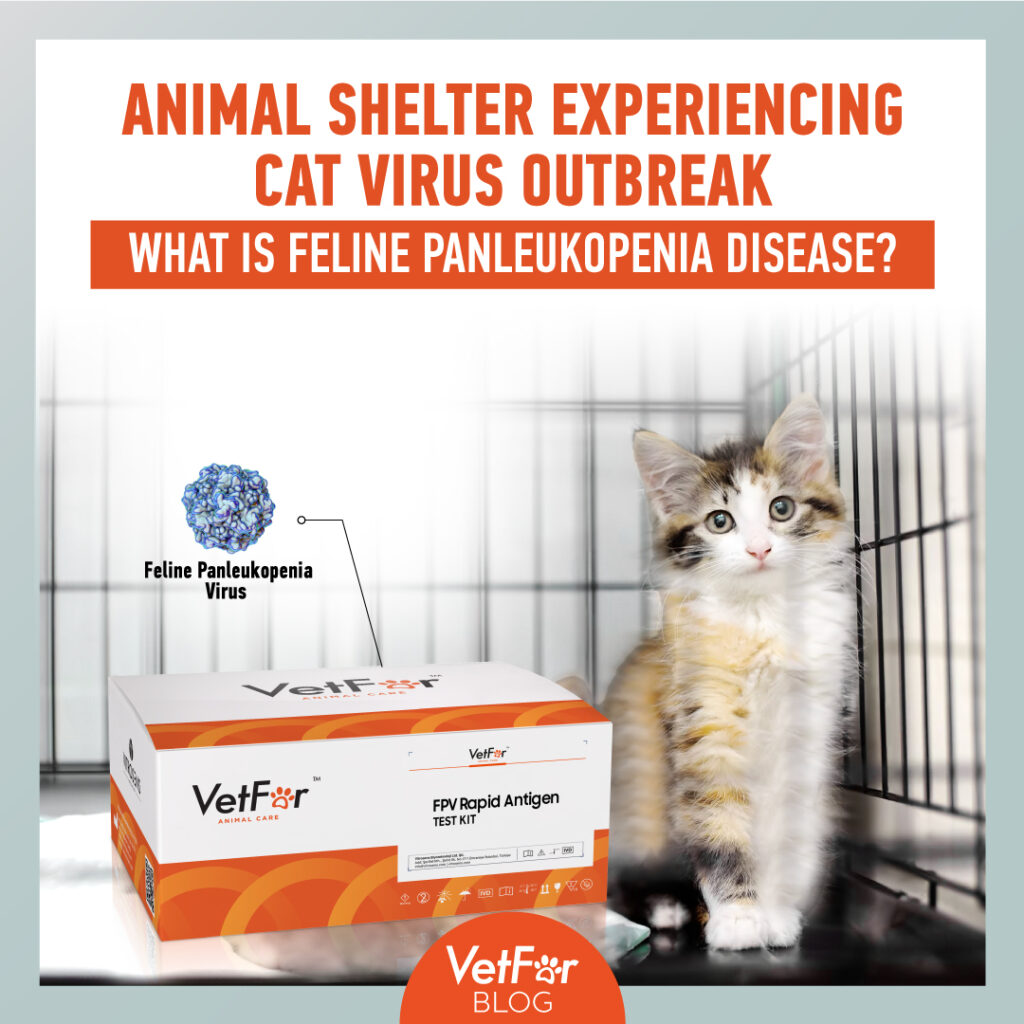In a concerning turn of events, the Prince George’s County Animals Services Facility and Adoption Center (ASFAC) is currently grappling with an outbreak of feline panleukopenia, a highly contagious viral disease that poses a significant threat to cats, particularly kittens. In this blog, we will delve into the details of what feline panleukopenia is, how it spreads, its symptoms, and most importantly, how cat owners can protect their feline companions.
Understanding Feline Panleukopenia
Feline panleukopenia, often referred to as feline distemper or feline parvo, is caused by the feline parvovirus. While the disease is uncommon today due to effective vaccines, it remains a serious concern, especially for young, sick, and unvaccinated cats. The virus targets rapidly dividing cells, affecting the bone marrow, intestines, and developing fetuses.
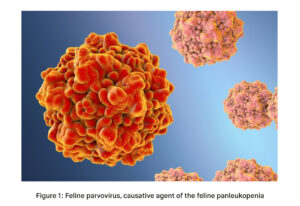
Transmission and Susceptibility
The virus is widespread in the environment, making virtually all kittens and cats susceptible at some point in their lives. Susceptibility is highest in young kittens, unvaccinated cats, and those in communal living situations like kennels, pet shops, and animal shelters. Cats can become infected through contact with an infected cat, their secretions, or even fleas from infected cats.
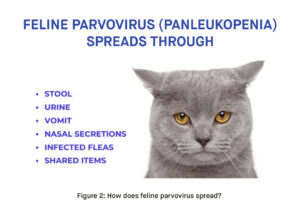
Symptoms of Feline Panleukopenia
Recognizing the symptoms of feline panleukopenia is crucial for early detection and intervention. Symptoms include loss of appetite, high fever, lethargy, vomiting, severe diarrhea, nasal discharge, and dehydration. The disease can be particularly devastating for cats aged 3-5 months, with mortality rates higher in this age group.
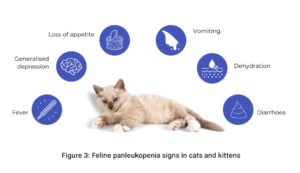
Diagnosis of Feline Panleukopenia
Diagnosing feline panleukopenia (FP) involves a combination of clinical evaluation, history assessment, and specific laboratory tests. Since the symptoms of FP can mimic those of other feline illnesses, a thorough diagnostic process is essential for accurate identification. Here’s an overview of the diagnostic methods used for feline panleukopenia:
- Clinical Signs and History:
- The veterinarian begins by gathering information about the cat’s history, including vaccination status, recent exposures, and any observed symptoms. Clinical signs, such as loss of appetite, vomiting, diarrhea, and lethargy, play a crucial role in guiding the diagnostic process.
- Physical Examination:
- A comprehensive physical examination is conducted to assess the overall health of the cat. This includes checking for signs of dehydration, abnormalities in the abdomen, and any neurological symptoms that may indicate severe cases of FP.
- Blood Tests:
- Blood tests are instrumental in diagnosing feline panleukopenia. The virus targets rapidly dividing cells, leading to a decrease in white blood cell counts (panleukopenia) and red blood cell counts (anemia). A complete blood count (CBC) is commonly performed to identify these changes.
- Fecal Testing:
- Since the virus is shed in the feces of infected cats, a fecal sample may be collected to detect the presence of the feline parvovirus. The virus can be identified through various laboratory techniques, such as polymerase chain reaction (PCR) testing.
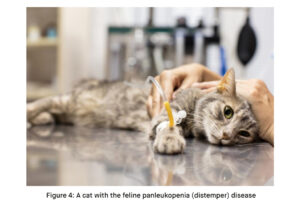
A cat with the distemper disease
- Since the virus is shed in the feces of infected cats, a fecal sample may be collected to detect the presence of the feline parvovirus. The virus can be identified through various laboratory techniques, such as polymerase chain reaction (PCR) testing.
-
History of Exposure:
- A crucial part of the diagnostic process involves obtaining information about the cat’s potential exposure to the virus. If the cat has been in contact with infected cats or environments where the virus is prevalent, it adds weight to the suspicion of feline panleukopenia.
- Clinical Assessment of Organ Damage:
- Feline panleukopenia can cause damage to organs such as the intestines and bone marrow. Biopsy or other imaging techniques may be employed to assess the extent of organ damage in severe cases.
- Serological Tests:
- Serological tests, which detect antibodies produced by the cat’s immune system in response to the virus, can aid in confirming a diagnosis. However, these tests may not be reliable during the early stages of infection.
- Isolation and Hygiene Practices:
- Given the highly contagious nature of feline panleukopenia, isolating the infected cat is crucial to prevent the spread of the virus. Proper hygiene practices, including disinfection of the environment and hands after handling infected cats, are essential to minimize the risk of transmission.
It’s important to note that diagnosing feline panleukopenia is a multifaceted process, and not all diagnostic methods may be applicable or conclusive in every case. Additionally, due to the severity of the disease, prompt veterinary attention is critical. If a cat is suspected of having feline panleukopenia based on clinical signs or exposure history, immediate isolation and veterinary consultation are recommended for a thorough diagnosis and appropriate treatment. Early intervention increases the chances of successful management and recovery from this potentially life-threatening viral infection.
Treatment Strategies
Regrettably, there is no specific antiviral medication tailored for feline panleukopenia. Treatment focuses on supportive care, aiming to correct dehydration, provide essential nutrients, and prevent secondary infections. Antibiotics often play a role in countering the increased risk of bacterial infections due to compromised immune systems. Early and intensive care becomes paramount in enhancing a cat’s chances of recovery.
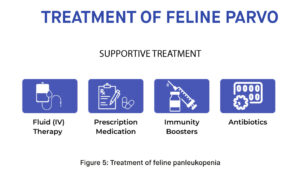
Prevention Measures
The key to safeguarding cats from feline panleukopenia lies in prevention. Vaccination is highly effective and should be administered to kittens between 6 and 16 weeks of age, with follow-up vaccines as recommended by veterinarians. Adult cats also require vaccination based on their health, age, and the risk of exposure in their environment.
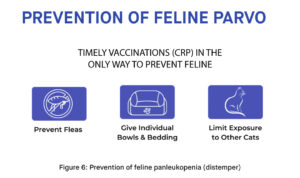
Current Outbreak at ASFAC
The recent outbreak at ASFAC led to the temporary closure of the cat nursery area, where the virus was contained. The facility remains open for adoptions, with standard deep cleaning protocols in place to minimize further spread. Cat parents are urged to stay vigilant, keep up with vaccinations, and follow hygiene practices to protect their feline friends.
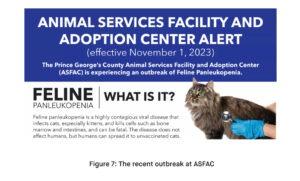
In conclusion, feline panleukopenia serves as a stark reminder of the importance of vaccinations and preventive measures in ensuring the well-being of our feline companions. As ASFAC works diligently to manage the current outbreak, cat owners everywhere are encouraged to consult their veterinarians, adhere to vaccination schedules, and stay informed about potential health risks in their communities. Together, we can create a safer and healthier environment for our beloved cats.
Which Test Kits Are Used to Diagnose Feline Panleukopenia Virus?
Introducing the FPV Rapid Antigen Test, a breakthrough in veterinary diagnostics designed for the in vitro detection of Feline Panleukopenia Virus (FPV) antigens in feline fecal samples. This innovative test kit offers a streamlined and simple procedure with minimal steps, providing veterinarians and cat owners with a user-friendly tool for efficient disease detection.
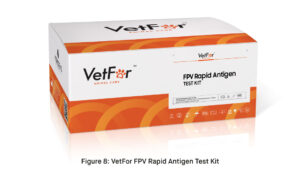
The advantages of this test extend beyond its simplicity, encompassing early diagnosis, a high level of accuracy, clear interpretation of results, and ultimately, an effective means of diagnosing Feline Panleukopenia. As a critical component in feline healthcare, this rapid antigen test empowers veterinary professionals and caregivers to take prompt and informed actions in managing this highly contagious viral disease.
REFERENCES
F. panleukopenia. American Veterinary Medical Association. https://www.avma.org/resources-tools/pet-owners/petcare/feline-panleukapenia
Wikimedia Foundation. (2023, December 11). Carnivore protoparvovirus 1. Wikipedia. https://en.wikipedia.org/wiki/Carnivore_protoparvovirus_1
Editorial, V. (2023, November 6). F. panleukapenia: Causes, signs, Treatment & Prevention of Cat Parvo. https://vetic.in/blog/pet-health/feline-parvo-fpv-causes-signs-treatment-prevention-of-panleukopenia-in-cats/
Wayne K. Curry Administration building. Prince George’s County. https://www.princegeorgescountymd.gov/departments-offices/news-events/news/county-animal-shelter-experiencing-cat-virus-outbreak
